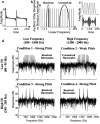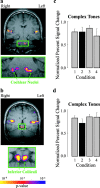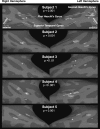A neural representation of pitch salience in nonprimary human auditory cortex revealed with functional magnetic resonance imaging
- PMID: 15282286
- PMCID: PMC1794212
- DOI: 10.1523/JNEUROSCI.0383-04.2004
A neural representation of pitch salience in nonprimary human auditory cortex revealed with functional magnetic resonance imaging
Abstract
Pitch, one of the primary auditory percepts, is related to the temporal regularity or periodicity of a sound. Previous functional brain imaging work in humans has shown that the level of population neural activity in centers throughout the auditory system is related to the temporal regularity of a sound, suggesting a possible relationship to pitch. In the current study, functional magnetic resonance imaging was used to measure activation in response to harmonic tone complexes whose temporal regularity was identical, but whose pitch salience (or perceptual pitch strength) differed, across conditions. Cochlear nucleus, inferior colliculus, and primary auditory cortex did not show significant differences in activation level between conditions. Instead, a correlate of pitch salience was found in the neural activity levels of a small, spatially localized region of nonprimary auditory cortex, overlapping the anterolateral end of Heschl's gyrus. The present data contribute to converging evidence that anterior areas of nonprimary auditory cortex play an important role in processing pitch.
Figures




References
-
- Bernstein JG, Oxenham AJ (2003) Pitch discrimination of diotic and dichotic tone complexes: harmonic resolvability or harmonic number? J Acoust Soc Am 113: 3323-3334. - PubMed
-
- Carlyon RP, Shackleton TM (1994) Comparing the fundamental frequencies of resolved and unresolved harmonics: evidence for two pitch mechanisms? J Acoust Soc Am 95: 3541-3554.
-
- Darwin CJ, Carlyon RP (1995) Auditory organization and the formation of perceptual streams. In: Handbook of perception and cognition, Vol VI, Hearing (Moore BCJ, ed), pp 387-424. San Diego: Academic.
-
- Fischl B, Sereno MI, Dale AM (1999) Cortical surface-based analysis. II. Inflation, flattening, and a surface-based coordinate system. NeuroImage 9: 195-207. - PubMed
Publication types
MeSH terms
Grants and funding
LinkOut - more resources
Full Text Sources
Medical
